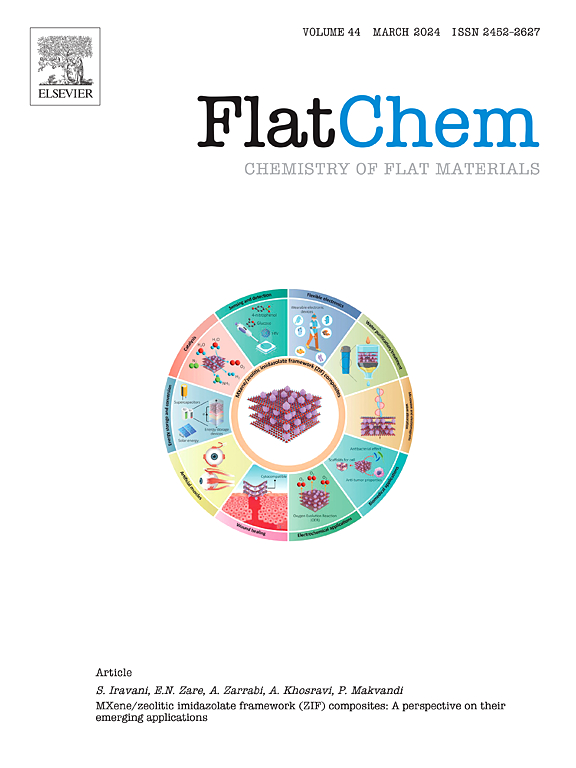Thickness- tuned band engineering for efficient photodetection in 2D CuInP2Se6
IF 6.2
3区 材料科学
Q2 CHEMISTRY, PHYSICAL
引用次数: 0
Abstract
The combination of unique narrow bandgap electronic and optical properties, along with van der Waals surfaces in 2D materials, makes this class of materials highly promising for advancing photodetectors. In this study, we employ first-principles calculations to investigate the structural, electronic, and vibrational properties of the 2D CuInP₂Se₆ van der Waals material. Theoretical studies reveal phase-dependent properties in CuInP₂Se₆, including bulk paraelectric, bulk ferroelectric, and monolayer paraelectric phases. Notably, the material exhibits a tunable electronic band structure through phase transitions and layer thickness modulation. Among the explored phases, the paraelectric monolayer demonstrates a strong second harmonic generation response while also displaying lower thermal conductivity, making it suitable for nonlinear optical applications. The theoretically predicted optical properties were validated experimentally by synthesizing CuInP₂Se₆ using multi-step solid-state and chemical vapor transport reactions. A fabricated photodevice, configured as Au/CuInP₂Se₆/SiO₂ via standard optical lithography, exhibited UV–visible photodetection with a maximum photoresponsivity at 405 nm. Similarly, a modelled photodevice with the same configuration also demonstrated photodetection, attaining a maximum photoresponsivity at 405 nm. Furthermore, encapsulating silicene is expected to further modulate the electronic band structure and enhance photodetection performance, paving the way for future advancements in integrated UV–Vis-NIR optoelectronic devices. The significant improvement in photoconductive gain in the NIR range is attributed to an efficient charge transport pathway and interfacial encapsulation.

二维CuInP2Se6中高效光电探测的厚度调谐带工程
独特的窄带隙电子和光学特性的结合,以及二维材料中的范德华表面,使得这类材料在推进光电探测器方面非常有前途。在这项研究中,我们采用第一性原理计算来研究二维CuInP₂Se₆范德华斯材料的结构、电子和振动特性。理论研究揭示了金棉货号的相依赖性质,包括大块准电相、大块铁电相和单层准电相。值得注意的是,该材料通过相变和层厚调制表现出可调谐的电子带结构。在所探索的相中,准电单层显示出强烈的二次谐波产生响应,同时也显示出较低的导热性,使其适合非线性光学应用。通过多步固相和化学气相输运反应合成CuInP₂Se₆,验证了理论预测的光学性质。通过标准光学光刻技术制备了Au/CuInP₂Se₆/SiO₂结构的光器件,在405nm处表现出最大的光响应性。同样,具有相同配置的光电器件模型也证明了光检测,在405 nm处获得了最大的光响应性。此外,封装硅烯有望进一步调制电子能带结构并增强光探测性能,为未来集成UV-Vis-NIR光电器件的发展铺平道路。在近红外范围内光导增益的显著改善是由于有效的电荷传输途径和界面封装。
本文章由计算机程序翻译,如有差异,请以英文原文为准。
求助全文
约1分钟内获得全文
求助全文
来源期刊

FlatChem
Multiple-
CiteScore
8.40
自引率
6.50%
发文量
104
审稿时长
26 days
期刊介绍:
FlatChem - Chemistry of Flat Materials, a new voice in the community, publishes original and significant, cutting-edge research related to the chemistry of graphene and related 2D & layered materials. The overall aim of the journal is to combine the chemistry and applications of these materials, where the submission of communications, full papers, and concepts should contain chemistry in a materials context, which can be both experimental and/or theoretical. In addition to original research articles, FlatChem also offers reviews, minireviews, highlights and perspectives on the future of this research area with the scientific leaders in fields related to Flat Materials. Topics of interest include, but are not limited to, the following: -Design, synthesis, applications and investigation of graphene, graphene related materials and other 2D & layered materials (for example Silicene, Germanene, Phosphorene, MXenes, Boron nitride, Transition metal dichalcogenides) -Characterization of these materials using all forms of spectroscopy and microscopy techniques -Chemical modification or functionalization and dispersion of these materials, as well as interactions with other materials -Exploring the surface chemistry of these materials for applications in: Sensors or detectors in electrochemical/Lab on a Chip devices, Composite materials, Membranes, Environment technology, Catalysis for energy storage and conversion (for example fuel cells, supercapacitors, batteries, hydrogen storage), Biomedical technology (drug delivery, biosensing, bioimaging)
 求助内容:
求助内容: 应助结果提醒方式:
应助结果提醒方式:


